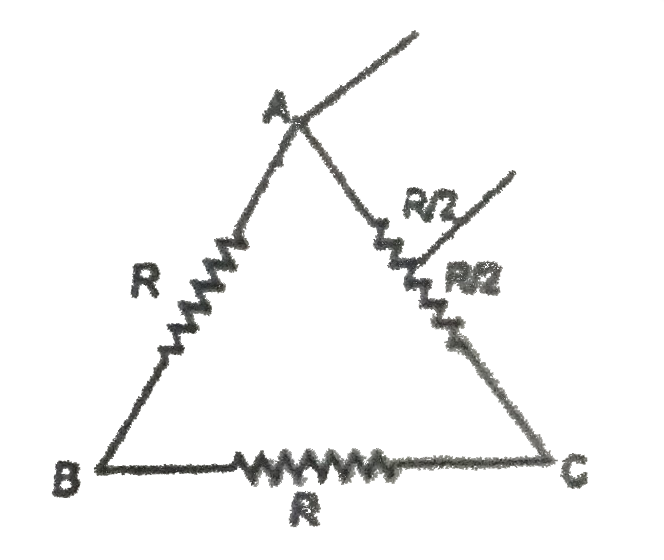A metal wire of resistance is elongated to make a uniform wire of double its previous length. This new wire is now bent and the ends joined to make a circle. If two points on this circle make an angle at the center, the equivalent resistance between these two points will be :
The correct Answer is:A
To solve the problem step by step, let's break it down:
Step 1: Understand the Initial Resistance
The initial resistance of the metal wire is given as R=3Ω.
Step 2: Determine the New Length and Area
When the wire is elongated to double its length, the new length L′ becomes:
L′=2L
Since the volume of the wire is conserved, we can express the relationship between the initial and final lengths and areas:
A⋅L=A′⋅L′
Substituting L′:
A⋅L=A′⋅(2L)
From this, we can derive the new area A′:
A′=A2
Step 3: Calculate the New Resistance
Using the formula for resistance:
R=ρLA
For the new wire, the resistance R′ is:
R′=ρL′A′=ρ2LA/2=ρ4LA
Since the initial resistance R=ρLA=3Ω, we find:
R′=4R=4×3Ω=12Ω
Step 4: Forming a Circle
The new wire of resistance 12Ω is bent into a circle. The total length of the wire is now the circumference of the circle:
C=2πr=2L′=2×2L=4L
Step 5: Determine the Length of the Arc
If two points on the circle make an angle of 60∘ at the center, the fraction of the circle corresponding to this angle is:
Fraction=60∘360∘=16
Thus, the length of the arc Larc between these two points is:
Larc=16×C=16×4L=2L3
Step 6: Calculate the Equivalent Resistance
Since the wire is uniform, the resistance of the arc can be calculated using:
Rarc=R′×LarcC
Substituting the values:
Rarc=12Ω×2L34L=12Ω×16=2Ω
Final Answer
The equivalent resistance between the two points on the circle is:
2Ω
The initial resistance of the metal wire is given as R=3Ω.
When the wire is elongated to double its length, the new length L′ becomes:
L′=2L
Since the volume of the wire is conserved, we can express the relationship between the initial and final lengths and areas:
A⋅L=A′⋅L′
Substituting L′:
A⋅L=A′⋅(2L)
From this, we can derive the new area A′:
A′=A2
Using the formula for resistance:
R=ρLA
For the new wire, the resistance R′ is:
R′=ρL′A′=ρ2LA/2=ρ4LA
Since the initial resistance R=ρLA=3Ω, we find:
R′=4R=4×3Ω=12Ω
The new wire of resistance 12Ω is bent into a circle. The total length of the wire is now the circumference of the circle:
C=2πr=2L′=2×2L=4L
If two points on the circle make an angle of 60∘ at the center, the fraction of the circle corresponding to this angle is:
Fraction=60∘360∘=16
Thus, the length of the arc Larc between these two points is:
Larc=16×C=16×4L=2L3
Since the wire is uniform, the resistance of the arc can be calculated using:
Rarc=R′×LarcC
Substituting the values:
Rarc=12Ω×2L34L=12Ω×16=2Ω
The equivalent resistance between the two points on the circle is:
2Ω
Topper's Solved these Questions
Similar Questions
Knowledge Check
A wire of resistance R is elongated n−fold to make a new uniform wire. The resistance of new wire.
AnRBn2RC2nRD2n2RA wire of resistance R is elongated n−fold to make a new uniform wire. The resistance of new wire.
An RBn2RC2 nRD2n2RA wire of resistance 4Ω is stretched to four times of its original length resistance of wire now becomes
A4ΩB8ΩC64ΩD16Ω
A wire has a resistance of 32Ω. It is melted and drawn into a wire of half of its original length. What is the resistance of the new wire?
View SolutionA uniform wire of resistance =3Ω and length l is stretched to double its length. Now it is bent to form a circular loop and two point P&Q lies on the loop such that they subtend 60∘ angle at centre. The equivalent resistance between two point P & Q is:
View SolutionA wire is bent in the form of a triangle now the equivalent resistance between its one end and the mid point of the side is

View SolutionA metallic wire of resistance 12Ω is bent to form a square. The resistance between two diagonal points would be
View SolutionA metallic wire of resistance 12Ω is bent of form a square. The resistance between two diagonal points would be
View Solution